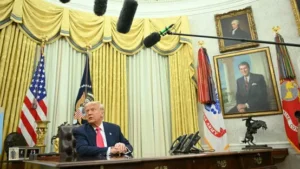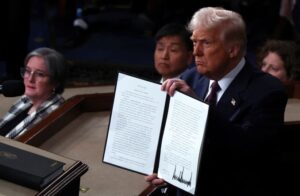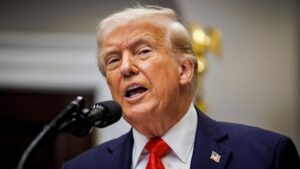Former U.S. President Donald Trump has revealed that he sent a letter to Iran’s Supreme Leader, Ayatollah Ali Khamenei, in an attempt to negotiate a new nuclear deal. Trump’s statement comes amid ongoing tensions between Washington and Tehran over Iran’s nuclear program and U.S.-imposed sanctions. While he did not disclose the exact contents of the letter, he emphasized his willingness to engage in diplomacy despite his administration’s “maximum pressure” campaign that saw the U.S. withdraw from the 2015 nuclear agreement in 2018.
Iran has not confirmed receiving Trump’s letter, and Khamenei has previously dismissed direct talks with Washington under pressure. The revelation raises questions about whether there were backchannel efforts to resolve the conflict during Trump’s presidency. With ongoing debates over the Iran nuclear issue under President Biden, Trump’s claim adds a new layer to the complex U.S.-Iran relationship. It remains uncertain if his outreach had any impact on the broader diplomatic landscape.
Trump’s Diplomatic Outreach

Trump’s letter to Khamenei was part of his broader strategy to address Iran’s behavior through a combination of direct diplomacy and maximum pressure. During his presidency, Trump pursued a “maximum pressure” campaign that included withdrawing from the 2015 nuclear deal and re-imposing sanctions on Iran. Despite the harsh rhetoric, Trump expressed a willingness to engage in direct talks with the Iranian leadership, believing that diplomacy could work if Iran were willing to come to the table.
Trump’s Message to Khamenei
According to Trump, the letter he sent to Khamenei was respectful and conveyed the possibility of dialogue. It emphasized that the U.S. was open to negotiating with Iran, but only under terms that would benefit American interests. Trump’s approach to diplomacy was often unconventional, and this letter was an example of his willingness to take bold steps to address long-standing global issues, even with adversarial nations like Iran.
The Timing of the Letter
The timing of the letter is notable, as it was sent amid heightened tensions between the U.S. and Iran, particularly after the U.S. assassination of Iranian General Qasem Soleimani in January 2020. The killing of Soleimani, a top military commander, prompted fears of an all-out conflict between the two nations. Despite the increasingly hostile environment, Trump’s letter represented a desire for communication, even as both sides engaged in military posturing and harsh rhetoric.
The Iranian Response

While Trump indicated that he had sent the letter to Khamenei, there was no immediate confirmation or detailed public response from Iran regarding the contents or reception of the letter. Given Iran’s mistrust of the U.S., particularly following Trump’s withdrawal from the JCPOA and the re-imposition of economic sanctions, it is unlikely that the Iranian leadership gave the letter significant attention. Iran had previously stated that it would not engage with the U.S. unless certain conditions were met, such as the lifting of sanctions and the U.S. returning to the nuclear deal.
Trump’s “Maximum Pressure” Campaign
During his presidency, Trump’s policy towards Iran was defined by the “maximum pressure” campaign, which aimed to force Iran to change its behavior by imposing severe economic sanctions. This strategy was intended to weaken the Iranian economy and bring the Iranian leadership to the negotiating table. While Trump also expressed a willingness to talk, the combination of sanctions and military threats created a highly charged atmosphere, making meaningful dialogue difficult.
Diplomatic Challenges
The U.S.-Iran relationship has been fraught with challenges, particularly since the 1979 Iranian Revolution, which led to the overthrow of the U.S.-backed Shah and the establishment of the Islamic Republic of Iran. Tensions have only escalated over the years, with issues such as Iran’s nuclear program, support for militant groups in the Middle East, and regional ambitions fueling further conflict. Despite these challenges, Trump’s outreach through the letter to Khamenei demonstrated his attempt to break the diplomatic deadlock.
Impact on U.S.-Iran Relations
Trump’s letter to Khamenei, while an attempt at diplomacy, also highlights the broader complexity of U.S.-Iran relations. Both nations have historically had a deep mistrust of one another, with the U.S. viewing Iran’s nuclear program and regional activities as significant threats. At the same time, Iran perceives the U.S. as an imperial power that seeks to dominate the Middle East. Even if both sides were open to dialogue, the many layers of history, distrust, and competing interests would make a breakthrough difficult.
Biden Administration’s Approach

With the transition to the Biden administration in 2021, U.S.-Iran relations have taken a different turn. President Joe Biden has expressed interest in re-entering the 2015 nuclear deal, which Trump had exited. However, talks between the U.S. and Iran have faced significant obstacles, including Iran’s demand for the lifting of sanctions before it resumes compliance with the nuclear deal. This issue remains one of the central points of contention in ongoing diplomatic efforts between the two nations.
The Future of U.S.-Iran Diplomacy
The future of diplomacy between the U.S. and Iran remains uncertain. While Trump’s letter to Khamenei reflected an openness to dialogue, the deep-rooted distrust between the two countries presents a significant barrier to meaningful negotiations. Moving forward, the U.S. and Iran will likely continue to engage in indirect talks through intermediaries, as both sides remain cautious of making significant concessions. The potential for direct dialogue and a resolution of key issues, such as Iran’s nuclear program and regional influence, will depend on both sides finding a way to address their core concerns and build trust.
Frequently Asked Questions
What did Trump reveal about Iran?
Trump stated that he sent a letter to Iran’s Supreme Leader to negotiate a nuclear deal.
When did Trump send the letter?
He did not specify the exact date, but it was during his presidency.
What was the purpose of the letter?
Trump aimed to engage Iran in talks for a new nuclear agreement.
Did Iran confirm receiving the letter?
Iran has not officially acknowledged receiving Trump’s letter.
Why did Trump withdraw from the 2015 nuclear deal?
He believed the agreement was flawed and sought a more restrictive deal.
Did Trump’s outreach lead to any negotiations?
No direct negotiations resulted from his efforts.
How did Iran respond to Trump’s policies?
Iran rejected negotiations under U.S. sanctions and pursued its nuclear program.
What is Biden’s stance on the Iran nuclear deal?
The Biden administration has sought to revive the 2015 agreement.
Why is Trump’s letter significant now?
It adds insight into past U.S.-Iran diplomacy amid ongoing tensions.
Could this impact future U.S.-Iran relations?
It depends on diplomatic efforts and shifts in leadership.
Conclusion
Trump’s revelation about sending a letter to Iran’s Supreme Leader highlights a lesser-known diplomatic attempt during his presidency. Despite his administration’s hardline stance, this move suggests he sought direct engagement with Tehran. However, Iran’s leadership showed little interest in negotiating under sanctions, leading to continued tensions between the two nations. The disclosure raises questions about potential backchannel diplomacy and how it may have influenced later U.S.-Iran interactions. Under President Biden, efforts to revive the 2015 nuclear deal have faced challenges, with Iran demanding stronger guarantees.

